Ray Mears northern Wilderness started this week on BBC2 – the first episode was a cracker. If you missed it you have 5 days left to catch it on bbc-iplayer.
Here’s Ray in his birchbark canoe, wrestling a rapid!

At the first sign of it getting colder and the leaves turning we loaded up and headed for an overnight trip down the Wye to catch the early autumn mood – leaving enough time for a late Autumn trip to follow before winter hopefully…
Just thought I’d collect my thoughts following a recent canoeing and ‘get out and stay out’ camping trip in the Wye valley. I’ve shared a few tips and ‘learns’ below that I’ve picked up in recent trips with the help of a touch of ‘backyard’ testing too.
Camp Fire! Firstly, respect your surroundings at all times, only light camp fires where and when they are allowed and keep it safe. Depending on where you are and if there are restrictions – find out and follow the rules. Extinguish remains and embers thoroughly as it can travel both over and under the ground.


Update. New Kelly Kettle Video Here.

old swag in a bag
There’s something to be said for not having a tent covering you up and hiding you away from the sky, especially when it’s fine. I guess in a tent, you’re not really out – you’re still ‘in’ and enclosed. Recently, I lay half under the half turned boat in my sleeping bag with nothing above me apart from a little dew and a million stars. As my old mate, Kevin, snored and grunted like a badger in his swag bag with only his beard on show, I listened to the Tawny Owls echoing in the valley, the splash of jumping fish in the Wye beside us and I picked out the shooting stars that were occasionally trailing and burning through the sky – sometimes I was momentarily tricked by the constant path and track of a man made one. The birds were singing at 4.30 and it was impossible to sleep so watching the sunrise in the valley was the next thing and it was going to be a scorcher. The ‘badger’ was awake too, not long after – and it was coffee, courtesy of good ol’ Kelly!
travelling light with your buddy
Old Red is our new canoe – an Old Town Discovery 158 in classic canoe red. We just returned from her maiden river trip, on the River Wye – here’s a great picture of Old Red pulled up at the bank, while Hawkeye looks out for birds in the woods on the river bank. We’ll post a full report of the trip here in the coming days – it was a great trip – still very wintery, no sign of green in the trees – just some early wild garlic out in the woods, and a few daffs and snowdrops. The birds were urging Spring on though with fantastic chorus of song coming from the woods and riverbanks.

Song of The Paddle and Path of The Paddle are inspirational books by Bill Mason who popularised the Open Canadian Canoe and Canoe camping like no other.
You can buy them on Amazon of course.
Update: See our latest test of the Green Outdoor full size Campfire Tent.
We’re on a mission. To seek out the best modern version of a traditional canvas tent, the “Baker Tent”.

The Baker Tent- image from www.tentsmiths.com
The basic attraction of this kind of tent or shelter is that it provides a living and sleeping space that is wide open to nature and environment and views around you, and yet sheltered enough from the elements. IN addition the classic Baker Tent is flexible in design, with a porch/roof and side wings all of which can be adjusted to suit the weather conditions. The Baker Tent is also known as the ‘Campfire Tent” which also gives a clue to it’s main attraction, that you can place the tent in front of the campfire whilst remaining under cover and out of any wind etc. In hot climates bugs and Mozzies are an issue of course with an ‘Open Tent’ design and this fact is the main reason why many ‘conventional’ tents don’t offer an open option – they assume the need to close up and exclude any biting insects. Whilst of course you can use mosquito netting with this tent, and you would want to in a hot climate location, but here in the UK with our temperate conditions and lack of any really nasty biting insects the open Camfire tent can really come into it’s own (exception would be clouds of midges in Scotland at certain times of year!) .
Our hunt for a modern version is not limited to replicas of the original camfire tent design such as those made by hand at www.camfiretent.co.uk but also includes any tent or tarp shelter that provides the same basic principles or cover, flexibility and openness to your surroundings, and to your campfire. This traditional 19th century design of tent had been kept alive in book form by the Great Bill Mason canoe-tripper and author of “The Song Of The Paddle” and recently regained popularity through the TV broadcasts of Ray Mears.
We’ll be udating you as we research and find a way to build buy or make the perfect modern version of the campfire Tent, The Baker Tent.
Stay Tuned!!!
AUtumn is one of the best times to be out canoing. Here’s the trip report:
Mid July, perfect weather and a 4 day run down the Wye, wild camping along the route. What a great trip that was, here’s how it went!